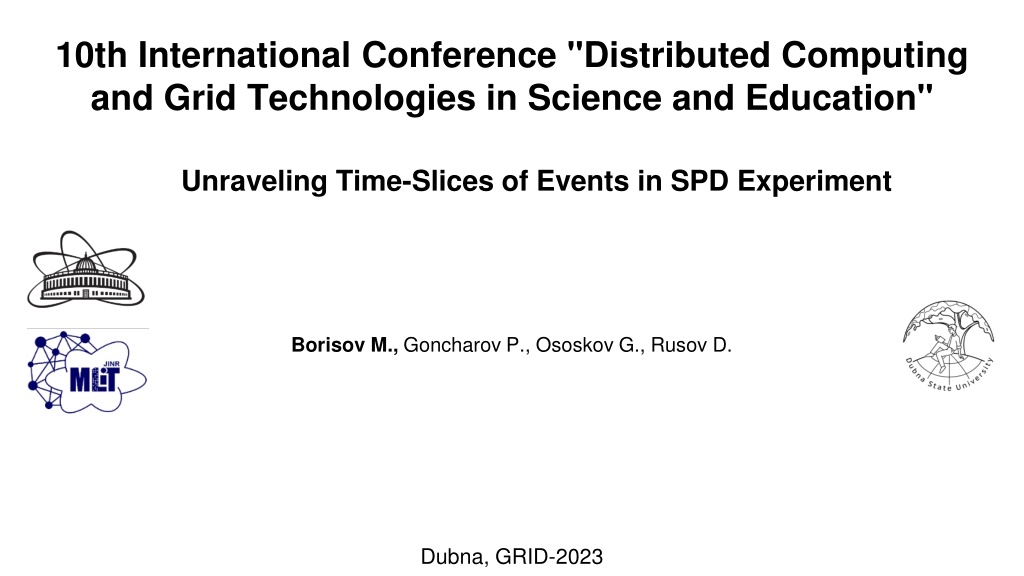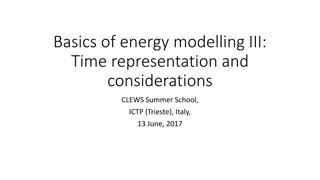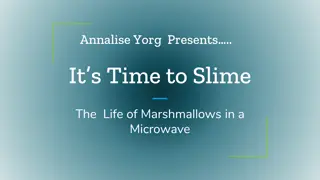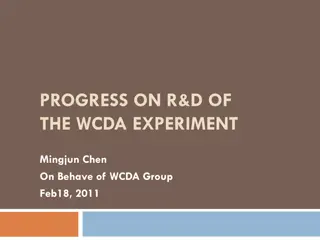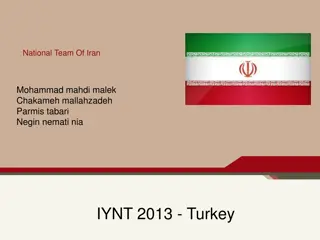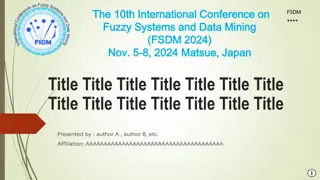Unraveling Time-Slices of Events in SPD Experiment at the 10th International Conference
In the context of the SPD experiment within the NICA project, the challenge lies in processing vast amounts of data efficiently to extract valuable events. The SPD experiment aims to study the spin structure of nucleons through polarized proton collisions. Approaches like predictive modeling, interpolation, and clustering are used to tackle the time-slice unraveling problem. The simulation involves Python scripts for simulating particle trajectories and detector configurations. Various models and techniques are explored to predict vertices and analyze the data.
Download Presentation

Please find below an Image/Link to download the presentation.
The content on the website is provided AS IS for your information and personal use only. It may not be sold, licensed, or shared on other websites without obtaining consent from the author. Download presentation by click this link. If you encounter any issues during the download, it is possible that the publisher has removed the file from their server.
E N D
Presentation Transcript
10th International Conference "Distributed Computing and Grid Technologies in Science and Education" Unraveling Time-Slices of Events in SPD Experiment Borisov M., Goncharov P., Ososkov G., Rusov D. Dubna, GRID-2023
Introduction SPD (Spin Physics Detector) is a future experiment of the NICA project. The main goal of the experiment is to check the predictions of quantum chromodynamics (QCD) and study the spin structure of nucleons through the collision of polarized protons. The frequency of events at the design luminosity of the collider will reach 3 MHz Only 2-5% of all events are of interest to physicists. 2
Problem Statement In the context of the SPD experiment within the NICA project, a significant challenge arises in processing vast amounts of data to extract valuable events. For the SPD experiment, in which events are expected to arrive with a frequency of 3 MHz, the data acquisition is supposed to be performed in time slices, during one time slice up to 40 events with overlapping tracks may appear. The process of extracting valuable events: Filtering events of interest Unraveling Time-Slices of Events Online tracking (TrackNET) *In the present task, it is assumed that the tracks are already recognized. doi.org/10.22323/1.429.0005 3
Simulation of events Python script for spiral approximation of particle trajectory. The number of tracks in each event is from 1 to 10. The transverse momentum of the particle is a random number with a uniform distribution in the range of values from 100 to 1000 MeV/s. The coordinates of the vertices are also random and are chosen from the known region of possible particle collisions. z The trajectory of the particle is represented by a set of points on a spiral segment. A detector configuration with 35 stations is considered. Detector inefficiency is modeled as the probability that a hit will be removed from the dataset. Detector efficiency values of 99% and 98% are used. y x Example of a model time-slice in the SPD experiment (for 10 events in a slide) 4
Approaches to solving the Unraveling Time-Slices of Events problem Predict vertices regression line/spline interpolation Clustering 1) k-means 2) Embedding mining Clustering Siamese network k-means 5
1.Predict vertices Models: Linear/spline interpolation Random Forest Regressor Gradient Boosting Decision Tree (GBDT) Distribution of real and predicted values Data preparation: Density 'loss_function': 'MAE' 'learning_rate': 0.0631 'iterations': 1743 'max_depth': 9 'l2_leaf_reg': 1.029 'bagging_temperature': 4.404 205.03 MSE 5.258 MAE 0.208 MAPE z 6
1.Model Interpretation summary plot SHAP (SHapley Additive exPlanations) is a game theoretic approach to explain the output of any machine learning model. The Shepley values for each trait are calculated by looking at all possible combinations of features and comparing model predictions with and without those features. x axis - effect on targeting y axis - sorted by importance features color - value of the target (blue is the smallest, red is the largest) thickness - concentration of observations the most important feature is the z-coordinate. 7
1.Clustering Clustering of vertices predicted by regression Number of clusters = Number of events in the slice Method: K-means z z cosine euclidean x Clustering is applied to each slice. x y y Vertex clustering result Vertex prediction result * In reality, we do not know exactly how many events are in the timeslice. In the experiments we use the exact number for proof of concept. 8 * demonstration for a slice with 5 events.
1.Clustering metrics (Internal) silhouette davies_bouldin The silhouette value shows how similar an object is to its cluster compared to other clusters. 5 10 40 5 10 40 slice samples 2019 1010 253 2019 1010 253 mean 0,82 0,79 0,65 0,25 0,26 0,43 The compactness as the distance from cluster objects to their centroids, and separability as the distance between the centroids. calculates Davies-Bouldin Index std 0,09 0,05 0,04 0,09 0,08 0,05 25% 0,78 0,75 0,63 0,10 0,21 0,39 50% 0,84 0,79 0,65 0,15 0,25 0,43 75% 0,89 0,83 0,68 0,22 0,31 0,46 9
1.Clustering metrics (External) * class labels are known slice 5 10 40 1. 1. Metrics are calculated based on the unambiguous matching of the predicted cluster to the event. 2. An event is considered unraveled if it has 1 cluster and is not included in other events. 3. A correctly unraveled slice is a slice with all events correctly unraveled; 2019 1010 253 samples 0,67 0,71 0,23 tracks percentage of correct 0,71 0,72 0,24 evts 0,32 0,46 0,02 slices slice 5 10 40 2. 1. For each cluster build a set of track_id, which are included in it. 2. Count the pairwise intersections of cluster sets and event sets. 3. Sort from greater to lesser intersection. 4. Find cluster-event pairs with the largest intersection. 5. If more than one cluster was found for some event, take only the one with the largest intersection. 6. Assign a label to each cluster, based on the found pair of event; 2019 1010 253 samples 0,864 0,355 0,291 Precision 0,886 0,491 0,124 Recall 0,857 0,401 0,046 F1-score 0,921 0,629 0,211 Accuracy 10 * in the future we want to test the Hungarian matching algorithm
Problems The main problem with the vertex prediction approach and further clustering is that they are close and overlapping. z Based on the received metrics, this approach is not applicable to unraveling 40 events in a slice. x y Vertex visualization for 40 events in the time slice. 11
2.Embedding mining (in progress) The idea is that tracks from one event are positive examples and tracks from different events are negative examples. The Siamese neural network must learn how to extract such vectors of embeddings for tracks. So that the vectors of tracks coming from the same vertex are close in the feature space. And vectors of tracks from different vertices are far away from each other in the feature space. The Siamese network works as a generator of feature vectors. 12
Conclusion and outlook An approach for predicting the vertex of an event has been developed. An approach for assessing the quality of clustering has been developed. Pipeline for unraveling events within a slice has been developed. But this approach turned out to be inapplicable for a large number of events in a slice. Make new features based on sequence Fourier transform, skewness, sliding windows Development of a Siamese network pipelining with a triplet error function. Clustering the results of the network. Testing SOTA clustering models 13
